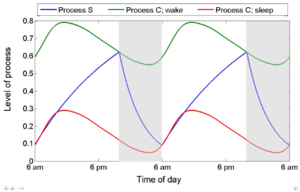Difference between revisions of "Regulation of Sleep and Wakefulness"
(help) |
(-Role of GABA and Acetylcholine in combination needs to be elaborated on, -cool model needs to be added, -sources etc) |
||
| (7 intermediate revisions by 2 users not shown) | |||
| Line 2: | Line 2: | ||
==Physiology== | ==Physiology== | ||
| − | The underlying physiology of sleep and wakefulness is complex. Different Neurons and Neurotransmitters promote different states of sleep and wakefulness. They are therefore categorised based on state-specific [[Discharge Patterns|discharge patterns]] and/or [[Transmitter Release|transmitter release]] and other neurobiological classifications. | + | The underlying physiology of sleep and wakefulness is complex. Different [[Neurons]] and [[Neurotransmitters]] promote different states of sleep and wakefulness. They are therefore categorised based on state-specific [[Discharge Patterns|discharge patterns]] and/or [[Transmitter Release|transmitter release]] and other [[neurobiological classifications]]. |
===State-specific discharge patterns=== | ===State-specific discharge patterns=== | ||
| − | Neurons are classifiable based on their discharge-pattern. During each behavioral state, there are neurons that fire at a higher rate as others. More specifically: | + | Neurons are classifiable based on their [[discharge-pattern]]. During each behavioral state, there are [[neurons]] that fire at a higher rate as others. More specifically: |
*Wake-On (/REM-Off) | *Wake-On (/REM-Off) | ||
| Line 13: | Line 13: | ||
===State-specific transmitter secretion=== | ===State-specific transmitter secretion=== | ||
| − | In neurobiology, neurons are also classified by their state-specific transmitter release. | + | In neurobiology, neurons are also classified by their [[state-specific transmitter release]]. |
| Line 47: | Line 47: | ||
====Two-process model of sleep==== | ====Two-process model of sleep==== | ||
| − | The two-process model of sleep is a conceptual model that aims to relate the behavioral state regulation to two main procedures. Process-S describes the increasing homeostatic pressure, the more time spent awake (Adenosine-alertness hypothesis | + | [[File:Two-process model of sleep graph.png|thumb|alt=|Graph of activity level of sleep processes over the course of a day. <br>Source: Natalia T., Megan H. H., Paige F., Victoria B. (2017). A Two-Process Model for Circadian and Sleep-dependent Modulation of Pain Sensitivity doi: https://doi.org/10.1101/09831]] |
| − | + | The two-process model of sleep is a conceptual model that aims to relate the behavioral state regulation to two main procedures. Process-S describes the increasing homeostatic pressure, the more time spent awake ([[Adenosine-alertness hypothesis]]) and deacreses during time spent asleep . Process C describes the ~24h circadian framework in which sleep can occur. | |
| − | |||
| − | ==== | + | ===== Equations ===== |
| + | S(t) | ||
| − | + | S(t) | |
| + | |||
| + | Ct) | ||
| + | |||
| + | Advantages: | ||
| + | |||
| + | * Good at explaining the basic phenomena of sleep and wakefulness | ||
| + | * Physiological basis for Process S is likely ([[Adenosine-alertness hypothesis]]) | ||
| + | |||
| + | Disadvantages: | ||
| + | |||
| + | * No physiological basis for Process C and interaction of Process S & C | ||
| + | * Does not include [[circadian pacemarkers]] and different [[sleep stages]] | ||
Latest revision as of 15:18, 26 December 2020
Sleep and wakefulness are regulated by a number of neurotransmitters, as well as neuromodulators within specific brain regions1.
Physiology
The underlying physiology of sleep and wakefulness is complex. Different Neurons and Neurotransmitters promote different states of sleep and wakefulness. They are therefore categorised based on state-specific discharge patterns and/or transmitter release and other neurobiological classifications.
State-specific discharge patterns
Neurons are classifiable based on their discharge-pattern. During each behavioral state, there are neurons that fire at a higher rate as others. More specifically:
- Wake-On (/REM-Off)
- Wake-On/ REM-On
- REM-On
- NREM-On
State-specific transmitter secretion
In neurobiology, neurons are also classified by their state-specific transmitter release.
Monoamines (here: serotonin, norepinephrine, histamine): Densest release during wakefulness.
Acetylcholine: Densest release during both wakefulness and REM sleep.
GABA ( γ-aminobutyric acid): Densest release during NREM sleep.
Neurotransmitters regulating behavioral states
Wakefulness
Acetylcholine, Serotonin, Norepinephrine, Histamine, Dopamine, Orexins, Glutamate (,GABA)
NREM
GABA, Adenosine
REM
Acetylcholine, GABA
The neurotransmitter GABA has brain region specific effects on behavioral states.
GABA in the pontine reticular formation promotes sleep and decreases wakfulness, by inhibiting the secretion of acetylcholine, which promotes Rem-sleep.
However, neurons activated by GABA in the basal forebrain fire the fastest during NREM sleep, and is NREM promoting.
Adenosine, the other major neurotransmitter involved in the onset of NREM sleep, increases proportional to the time spent awake in the basal forebrain. It is the neurotransmitter thouoght to be the major regulator of Process S in the 2-Process Model of Sleep.
Models
In order to comprehend the mechanisms better, conceptual models of sleep-wake regulation have been created. In addition to the conceptualised models, mechanical models co-exist, that aim to describe the underlying physiology of the mechanisms in more detail.
Two-process model of sleep

Source: Natalia T., Megan H. H., Paige F., Victoria B. (2017). A Two-Process Model for Circadian and Sleep-dependent Modulation of Pain Sensitivity doi: https://doi.org/10.1101/09831
The two-process model of sleep is a conceptual model that aims to relate the behavioral state regulation to two main procedures. Process-S describes the increasing homeostatic pressure, the more time spent awake (Adenosine-alertness hypothesis) and deacreses during time spent asleep . Process C describes the ~24h circadian framework in which sleep can occur.
Equations
S(t)
S(t)
Ct)
Advantages:
- Good at explaining the basic phenomena of sleep and wakefulness
- Physiological basis for Process S is likely (Adenosine-alertness hypothesis)
Disadvantages:
- No physiological basis for Process C and interaction of Process S & C
- Does not include circadian pacemarkers and different sleep stages